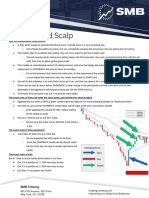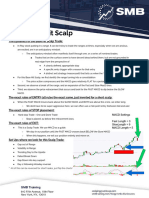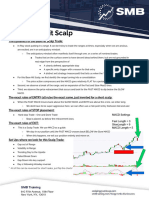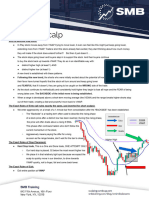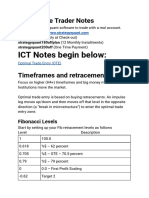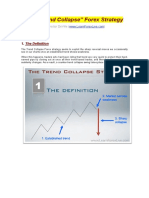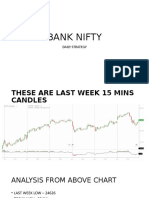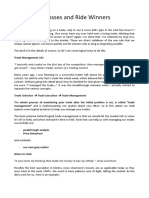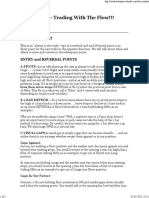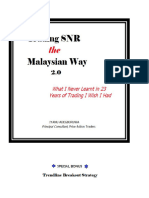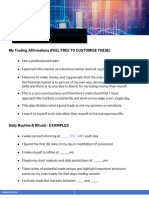Professional Documents
Culture Documents
MACD Base Hit Cheat Sheet
Uploaded by
PratyushOriginal Title
Copyright
Available Formats
Share this document
Did you find this document useful?
Is this content inappropriate?
Report this DocumentCopyright:
Available Formats
MACD Base Hit Cheat Sheet
Uploaded by
PratyushCopyright:
Available Formats
The Dynamics of the Base Hit Scalp Trade:
● In Play stock putting in a range. It can be tricky to trade the ranges at times, especially when we are anxious,
are excited, are in an anticipatory mindset.
○ The anticipatory mindset often manifests itself through one, or a series of invetned trades.
■ Trades that on the surface seem to have decent ideas behind them, but are not grounded in
real edge from the perspective of
● A clearly defined, appropriate stop
● A specific entry trigger with a reason for that entry
● A distinct exit strategy (reason2sell) that tells us when the “meat” of the move is done
● For this Base Hit Scalp, we first dentify the range turning into a consolidation
○ The price action compresses and the MACD goes relatively FLAT for a period of 3-15 minutes
● Second, we observe a break of the range, and an expansion of the Fast and Slow MacD lines.
● Third, we observe the price retracement that occurs and look for the FAST MACD to dip below the SLOW
MACD.
The exact rules of ENTRY (all rules the exact same, just inverted for a short scalp:
● When the FAST MACD moves back above the SLOW MACD, and BOTH are above the 0 line, we enter long
○ We dont have to be super aggressive here, we can often use a mid-point entry (between bid and ask)
The exact rules of STOP placement:
● Hard stop Trade - One and Done Trade
○ Stop is placed .02 below the retracement lows.
The exact rules of EXIT:
● This is a Scalp Trade. We use MACD as a guide.
○ We stay in our position until the FAST MACD crosses back BELOW the Slow MACD
○ When this happens, we exit our position entirely and move on.
Set Ups where we look for this Scalp Trade:
● Gap out of Range
● Volatility in Range
● Trending Day to the Upside
● Failed Break Down
● Gap Down into key support
● Day 2 following intraday reversal
** All of this can be reversed for short trades, just flip the charts!
You might also like
- Winning Binary Options Trading Strategy: Simple Secret of Making Money From Binary Options TradingFrom EverandWinning Binary Options Trading Strategy: Simple Secret of Making Money From Binary Options TradingRating: 4.5 out of 5 stars4.5/5 (23)
- Volatility Index 75 Strategy: Think Beyond The LimitsDocument13 pagesVolatility Index 75 Strategy: Think Beyond The LimitsTieba issouf Ouattara100% (1)
- Hitchhiker Scalp Cheat Sheet-2Document2 pagesHitchhiker Scalp Cheat Sheet-22thnzkcssj100% (6)
- Institutional Order Flow BasicsDocument14 pagesInstitutional Order Flow BasicsNnogge Lovis0% (1)
- The Rubberband Scalp Cheat SheetDocument2 pagesThe Rubberband Scalp Cheat SheetZeeshan BakaliNo ratings yet
- Intraday Trading StrategiesDocument6 pagesIntraday Trading Strategiesmdjauhar63% (16)
- MACD Cheat SheetDocument1 pageMACD Cheat Sheetsasa332138No ratings yet
- MACD Cheat Sheet - 1710631898320Document1 pageMACD Cheat Sheet - 1710631898320zarko594No ratings yet
- Back$Ide Cheat SheetDocument2 pagesBack$Ide Cheat SheetZeeshan Bakali100% (1)
- Simple Setups For Weekly Income WorkshopDocument68 pagesSimple Setups For Weekly Income WorkshopShu'l Gz MrtinzNo ratings yet
- ICT Notes Begin Below:: Inner Circle Trader NotesDocument31 pagesICT Notes Begin Below:: Inner Circle Trader NotesAbi100% (1)
- Thelcoin WhitepaperDocument19 pagesThelcoin WhitepapervchsrikanthNo ratings yet
- ICT 2022 Mentorship Key PointsDocument7 pagesICT 2022 Mentorship Key Pointsskyed84No ratings yet
- Kind Martin Strategy For Forex Trading: AdvancedDocument8 pagesKind Martin Strategy For Forex Trading: Advancedali BabahNo ratings yet
- UntitledDocument36 pagesUntitledEdwin WongNo ratings yet
- Magic Forex DivergenceDocument12 pagesMagic Forex DivergenceGenesisGenesisNo ratings yet
- Magic For Ex DivergenceDocument12 pagesMagic For Ex DivergenceAbi AbdurrahmanNo ratings yet
- Tim Trush & Julie Lavrin: Trading GuideDocument12 pagesTim Trush & Julie Lavrin: Trading Guidenathaniel ekaikoNo ratings yet
- Divergence Master TraderDocument17 pagesDivergence Master TraderIvica Matic0% (1)
- Trading Strategies For The ShortDocument4 pagesTrading Strategies For The ShortChrisLaw123No ratings yet
- PDF TrendCollapse PDFDocument6 pagesPDF TrendCollapse PDFMj ArNo ratings yet
- Holy Graily Bob 'N Dottybot User GuideDocument13 pagesHoly Graily Bob 'N Dottybot User GuideGabriel La MottaNo ratings yet
- The Second Chance Scalp Cheat SheetDocument2 pagesThe Second Chance Scalp Cheat SheetZeeshan BakaliNo ratings yet
- The Ultimate Crypto Trading Course (For Beginners) Episode 8 - Analysis ProcessDocument15 pagesThe Ultimate Crypto Trading Course (For Beginners) Episode 8 - Analysis ProcesssouravNo ratings yet
- Volatility Indices Strategy: Explained (Emphasis On Volatility 75 Index)Document9 pagesVolatility Indices Strategy: Explained (Emphasis On Volatility 75 Index)Thabani Albert SifuyaNo ratings yet
- Volatility Indices Strategy: Explained (Emphasis On Volatility 75 Index)Document9 pagesVolatility Indices Strategy: Explained (Emphasis On Volatility 75 Index)Dennis MuzilaNo ratings yet
- The Fashionably Late Scalp Cheat SheetDocument2 pagesThe Fashionably Late Scalp Cheat SheetZeeshan BakaliNo ratings yet
- Chapter 8 SummaryDocument16 pagesChapter 8 SummaryColor BlackNo ratings yet
- Bollinger BandsDocument10 pagesBollinger Bandsarvindk.online6095No ratings yet
- Trading Strategies NotesDocument3 pagesTrading Strategies Notesrnjuguna100% (1)
- Trading Plan: General RulesDocument8 pagesTrading Plan: General Rulesهادی جهانیNo ratings yet
- Intr Say Tra NG StraesDocument6 pagesIntr Say Tra NG Straesspajk6No ratings yet
- 10.day Trading StrategyDocument35 pages10.day Trading StrategyrocimoNo ratings yet
- Confirmed MDocument27 pagesConfirmed Mkhatrimanish9813No ratings yet
- Momentum TradingDocument59 pagesMomentum Tradingyogesh nanda100% (2)
- Bank Nifty: Daily StrategyDocument25 pagesBank Nifty: Daily Strategyalistair7682No ratings yet
- MMT RojanDocument27 pagesMMT RojanRoshan Giri0% (1)
- Cut Losses Ride Winners v1Document8 pagesCut Losses Ride Winners v1jjaypowerNo ratings yet
- The Method - Trading With The Flow!!!Document3 pagesThe Method - Trading With The Flow!!!K JNo ratings yet
- Trend Jumper: Special Tactics For The YM 5 Minute ChartDocument6 pagesTrend Jumper: Special Tactics For The YM 5 Minute ChartbollingerbandNo ratings yet
- ST Sir Swing Trade With Smaller StoplossDocument6 pagesST Sir Swing Trade With Smaller StoplossUsha JagtapNo ratings yet
- Swing Trading VelezDocument15 pagesSwing Trading Velezcosti.sorescu89% (9)
- The Rubber Band Reversal StrategyDocument9 pagesThe Rubber Band Reversal StrategysafarisinferrarisNo ratings yet
- Notes: Trading Strategies 3-13-39 Days EMADocument10 pagesNotes: Trading Strategies 3-13-39 Days EMAChenna VenkatasubbaiahNo ratings yet
- Forex - Market Structure - OctaFX - LTSDocument27 pagesForex - Market Structure - OctaFX - LTSbalajiminerals555No ratings yet
- Swing Trading The Speculator Way 124Document10 pagesSwing Trading The Speculator Way 124KL RoyNo ratings yet
- Trading PlanDocument8 pagesTrading PlanManuel Garcia PaulaNo ratings yet
- Book 2 Trading 1Document91 pagesBook 2 Trading 1Pavel StarkovNo ratings yet
- Highly Successful Stock Investment Formula at Short-term: Equation of Stock Investment in Which Even Beginners Learn and Make Profits EasilyFrom EverandHighly Successful Stock Investment Formula at Short-term: Equation of Stock Investment in Which Even Beginners Learn and Make Profits EasilyNo ratings yet
- MACD - Trading The MACD DivergenceDocument7 pagesMACD - Trading The MACD DivergenceAaron DrakeNo ratings yet
- Bearish Engulfing Pattern Trading Strategy GuideDocument17 pagesBearish Engulfing Pattern Trading Strategy GuideVinesh Singh100% (1)
- Trading For Beginners Part 2 - Sample-Trade-Plan-2Document8 pagesTrading For Beginners Part 2 - Sample-Trade-Plan-2Domingos AlbertoNo ratings yet
- The Advanced Trend Trade 2.0Document24 pagesThe Advanced Trend Trade 2.0Eloy CastellanosNo ratings yet
- TRADER 27 - THE GRINDER Rev. 1 1Document10 pagesTRADER 27 - THE GRINDER Rev. 1 1agathfutureNo ratings yet
- Forex Pivot Points: Here Is An Example of Pivot Points Plotted On A 1 Hour EUR/USD ChartDocument7 pagesForex Pivot Points: Here Is An Example of Pivot Points Plotted On A 1 Hour EUR/USD ChartAalon Sheikh100% (1)
- Trading The Pivots, Support and ResistanceDocument6 pagesTrading The Pivots, Support and ResistanceVictoria Schroeder100% (1)
- Double Bollinger Band MACD Stochastic Crossover Forex StrategyDocument7 pagesDouble Bollinger Band MACD Stochastic Crossover Forex Strategyanand_studyNo ratings yet
- Professional Day Trading & Technical Analysis Strategic System For Intraday Trading Stocks, Forex & Financial Trading.From EverandProfessional Day Trading & Technical Analysis Strategic System For Intraday Trading Stocks, Forex & Financial Trading.No ratings yet
- Crypto Scalping Strategies: Day Trading Made Easy, #3From EverandCrypto Scalping Strategies: Day Trading Made Easy, #3Rating: 3 out of 5 stars3/5 (2)




